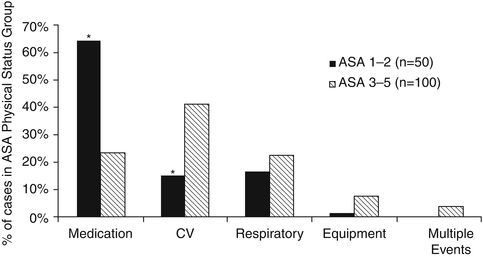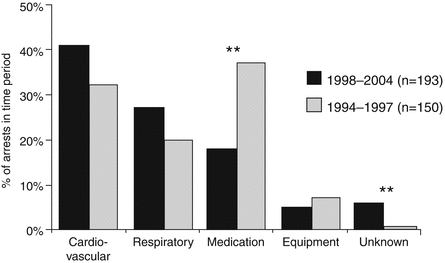Fig. 9.1
Methodological overview of POCA registry (Reproduced from BMJ Quality and Safety; Posner et al. [4], copyright 2002 with permission from BMJ Publishing Group Ltd)
For each case, an 8-page case report form with 14 sections was completed by the institutional representative and submitted to the Registry. These 14 sections included patient data (demographic variables, ASA status), procedure data (surgical procedure and type, type of anesthetic, time of induction), personnel involvement (all providers involved in care at time of arrest including amount of training of attending anesthesiologist and if the attending was present at the time of arrest), sedation (details on type of sedation techniques used, if applicable), premedications, regional anesthesia use, general anesthesia use (types of medications used to induce and maintain anesthesia including details on anesthetic depth), status immediately prior to cardiac arrest (position of patient, level of airway support, monitors used, and clinical warnings prior to arrest), status during cardiac arrest (including location of arrest, and the presumed cause of arrest), resuscitation data (times of and all treatments given during resuscitation), outcome of cardiac arrest (including severity of injury after arrest), an overall assessment section, follow up criteria, and a written narrative of the events. A follow up form was submitted if certain information regarding the arrest had yet to be clarified, or if the injury sustained during the arrest had not yet fully evolved.
Findings
There were three main analyses using POCA Registry data and each contributed something different to understanding the incidence and factors associated with pediatric anesthesia cardiac arrest.
First Analysis
The first report from the POCA Registry [6] confirmed what was suspected by some pediatric anesthesiologists, that the use of halothane, even in acceptable doses, appeared to have contributed to many cases of cardiac arrest. The most common mechanisms of anesthesia-related cardiac arrest in children in POCA Registry case reports were medication (mostly halothane alone or in combination with other anesthetic agents) and cardiovascular events. Infants (less than 12 months of age) accounted for greater than half of POCA Registry case reports of cardiac arrest related to anesthesia. This finding was consistent with previous reports of higher risk of cardiac arrest in infants. Other causes of arrest included respiratory system problems (20 %, most commonly laryngospasm and airway obstruction) and equipment (7 %, mainly central venous catheters). Interestingly, the proportionate causes of arrest varied significantly between healthy (ASA physical status 1–2) and chronically ill (ASA physical status 3–5) patients (Fig. 9.2) [6]. The most common cause of anesthesia-related arrest in healthy children was medication-related while arrest in chronically ill children was more often cardiovascular in nature. The figure represents proportionate risk data within the POCA Registry sample of anesthesia-related perioperative arrests and not a representation of absolute risk within the general pediatric population.


Fig. 9.2
Cause of Cardiac Arrest by Category, Stratified by ASA Physical Status. *p < 0.01 compared with ASA physical status 3–5 patients. CV cardiovascular (Reproduced from Morray et al. [6] with permission from Wolters Kluwer Health)
Another major finding from this initial report was analysis of factors associated with mortality from perioperative cardiac arrest. ASA physical status of 3–5 (odds ratio of 13, 95 % CI 2.9–57.7) and emergency surgery (odds ratio of 4, 95 % CI 1.6–9.6) were associated with mortality following anesthesia-related cardiac arrest in the POCA Registry data. After adjusting for these factors, age group and type of surgery were not predictive of mortality. Although infants represented a higher proportion of cardiac arrest cases in the POCA Registry, and this seemed to be related to cardiovascular suppression effects of halothane, outcome (mortality) from a cardiac arrest was only related to ASA physical status and whether or not the surgery was emergent (rather than age). While anesthesia-related cardiac arrest was more common in infants, once arrest occurred, healthier patients undergoing elective surgery were more likely to be successfully resuscitated than sick infants.
The data from this first report was the best data to capture an accurate incidence estimate of cardiac arrest (1.4 arrests per 10,000 anesthetics delivered) given the participation and compliance was most likely highest during the first few years of the Registry. Several subsequent studies would later estimate similar rates of anesthetic-related perioperative cardiac arrest and mortality (Table 9.1) [6–13], but most had nowhere near the number of patients studied as were enrolled in the POCA Registry. This incidence estimate may not be as relevant today since halothane is rarely used in the United States, but it was relevant at the time it was published and is not far from more recent estimates. While this estimate of the rate of cardiac arrest was considered an accurate estimate based on the POCA Registry institutions, it represented only those institutions participating in the POCA Registry. As in all similar estimates, its relationship to total US incidence of cardiac arrest among pediatric anesthesia patients was impossible to assess.
Table 9.1
Incidence estimates of perioperative cardiac arrest in pediatric patients including POCA results (in italics)
Source | Years represented | Sample size | No. of hospitals | Country | Perioperative CA ratea | Perioperative CA mortalityb | Case fatality (%)c |
|---|---|---|---|---|---|---|---|
Morray et al. [6] | 1994–1997 | 1,089,200 | 63 | US/Canada | 1.4 | 0.36 | 26 |
Kurth et al. [7] | 2010–2013 | 736,365 | 19 | US | 3.27d | 1.06 | 32 |
van der Griend et al. [8] | 2003–2008 | 101,885 | 1 | Australia | NR | 0.98 | NR |
Flick et al. [9] | 1988–2005 | 92,881 | 1 | US (Minnesota) | 0.65 | 0.22 | 33 |
Murat et al. [10] | 2000–2002 | 24,165 | 1 | France | 0.8 | 0 | 0 |
Ahmed et al. [11] | 1992–2006 | 20,216 | 1 | Pakistan | 2.0 | 0.49 | 25 |
Newland et al. [12] | 1989–1999 | 16,051 | 1 | US (Nebraska) | 1.9 | 0 | 0 |
Tay et al. [13] | 1997–1999 | 10,000 | 1 | Singapore | 1d | 0 | 0 |
Second Analysis
The second report from the POCA Registry [14] comparing anesthesia-related cardiac arrest from 1998–2004 to those from 1994–97 suggested a shift in the causes of cardiac arrest from the first report, as halothane use for pediatric anesthesia had declined substantially over time. Medication-related arrests decreased by approximately half between the first and second report (Fig. 9.3) [14], with halothane-related arrests decreasing from 25 % of all anesthesia-related arrests in the first publication to only 5 % in 1998–2004. Additionally, cardiac arrest in ASA 1 patients was less common in the second analysis compared to the earlier report (7 % vs. 15 %). The more prevalent causes of arrest being reported in 1998–2004 were cardiovascular (41 % of anesthesia-related arrests in 1998–2004, Fig. 9.3) with the most common identifiable cardiovascular mechanisms of arrest identified as hypovolemia from blood loss or complications from inappropriate fluid resuscitation and blood transfusion (usually hyperkalemia). As hypovolemia associated with blood loss was the most common cause, the cause of this hypovolemia was analyzed in detail. This analysis revealed that an underestimation of blood loss was the most common cause of hypovolemia leading to cardiovascular-related cardiac arrest in children (48 % of cases). The next most common cardiovascular causes of perioperative cardiac arrest were inadequate peripheral venous access (22 %) and not having (or not transducing) a central venous catheter, thus underestimating the patient volume status (22 %).
 < div class='tao-gold-member'>
< div class='tao-gold-member'>





Only gold members can continue reading. Log In or Register to continue
Stay updated, free articles. Join our Telegram channel

Full access? Get Clinical Tree


